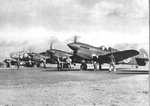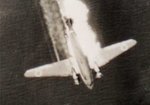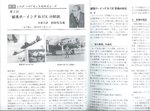Foreign Aircraft in Japanese Markings
- Thread starter syscom3
- Start date
Ad: This forum contains affiliate links to products on Amazon and eBay. More information in Terms and rules
More options
Who Replied?- Thread starter
-
- #62
syscom3
Pacific Historian
Wildcat.... that picture of a "Tabby" that was shot down, it was by a B24 who happened across it over the Maluku's.
It was a 380th BG B24 from Darwin that did it.
It was a 380th BG B24 from Darwin that did it.
I am sorry not reading the thread a while. There are one detailed article about captured B-17s published in the Koku Asahi Magazine May 1943 issue. It was re-published in May 2005 issue of the PILOT magazine from Japan Aircraft Pilot Association.
This was not a formal military report but the author Capt. Odagiri made a really fine job. In my opinion this gave the Japanese readers not only about the B-17 but also the modern warplanes' perspective in general, including Japanese ones which had been kept under strict secrecy during wartime. I will pick up some of the contents later.
This was not a formal military report but the author Capt. Odagiri made a really fine job. In my opinion this gave the Japanese readers not only about the B-17 but also the modern warplanes' perspective in general, including Japanese ones which had been kept under strict secrecy during wartime. I will pick up some of the contents later.
Attachments
Following is my quick job, starting with the first section;
Section 1. What the "Flying Fortress" means
It has been commonly understood that the words "flying fortress" was for a large bomber. But the true meaning is that the B-17 is "easy to defend, hard to shoot down." In this the type is not the largest bomber aircraft.
It should be noted that the B-17 had first flown nine years ago, in 1934, has since been developed to have more performance in height and speed, defensive armaments and added protections against enemy bullets and fire in flight.
The model B-17E we tested had most of its parts stamped January or March 1941 meant the aircraft was delivered to Java shortly before the war broke out and subsequently captured by our forces there.
To be continued
Section 1. What the "Flying Fortress" means
It has been commonly understood that the words "flying fortress" was for a large bomber. But the true meaning is that the B-17 is "easy to defend, hard to shoot down." In this the type is not the largest bomber aircraft.
It should be noted that the B-17 had first flown nine years ago, in 1934, has since been developed to have more performance in height and speed, defensive armaments and added protections against enemy bullets and fire in flight.
The model B-17E we tested had most of its parts stamped January or March 1941 meant the aircraft was delivered to Java shortly before the war broke out and subsequently captured by our forces there.
To be continued
Attachments
Section 2; Characteristics of the airplane
At first glance the B-17 looks like a very neat one, but actual design of the airplane is very old. If a Japanese airplane designers look at it, he would say "I think I can design a better one" or even a high school student with some aeronautical knowledge would argue " I would modify this and that on the plane."
It is far from our idea that airplanes can be obsolescent very soon. The B-17 has been living nearly for ten years but it is still in front line service. This is appearently because the airplane has a host of modern and new equipment, like an old lady still looks nice by having special kind of medications and nutritions continuously.
Modern equipment include; exhaust gas turbines, Norden bomb sight, defensive armaments and a Sperry gun sight (for ventral turret) and an allay of armor plates.
There could be an argument that if these superb equipment exists, why don't the Americans put them use on newer design airplane. This could be responded that ;
1) the aiplane company must be trained and used to manufacture planes like B-17 over a long period.
2) the design allowed a mass-production. After examining closely we got that the production man-hour for making a B-17 could be as small as 1/10 of what we had been thinking.
3) a straightforward designing of the original model allowed the E model to be almost an ideal package in having equipment listed above, adequate weights, ample interior spaces and the adequate wing loadings. And,
4) the airplane posseses an extremely easy control overall.
From these it can be assumed that the enemy will replace the B-17 with modern types within a year as much.
-----------
Technical details follows.
At first glance the B-17 looks like a very neat one, but actual design of the airplane is very old. If a Japanese airplane designers look at it, he would say "I think I can design a better one" or even a high school student with some aeronautical knowledge would argue " I would modify this and that on the plane."
It is far from our idea that airplanes can be obsolescent very soon. The B-17 has been living nearly for ten years but it is still in front line service. This is appearently because the airplane has a host of modern and new equipment, like an old lady still looks nice by having special kind of medications and nutritions continuously.
Modern equipment include; exhaust gas turbines, Norden bomb sight, defensive armaments and a Sperry gun sight (for ventral turret) and an allay of armor plates.
There could be an argument that if these superb equipment exists, why don't the Americans put them use on newer design airplane. This could be responded that ;
1) the aiplane company must be trained and used to manufacture planes like B-17 over a long period.
2) the design allowed a mass-production. After examining closely we got that the production man-hour for making a B-17 could be as small as 1/10 of what we had been thinking.
3) a straightforward designing of the original model allowed the E model to be almost an ideal package in having equipment listed above, adequate weights, ample interior spaces and the adequate wing loadings. And,
4) the airplane posseses an extremely easy control overall.
From these it can be assumed that the enemy will replace the B-17 with modern types within a year as much.
-----------
Technical details follows.
Chapter3. Anatomy of the B-17, part one
This is the main part of the whole but I won't translate all. The Army tested the following;
-Dimensions and weights
-The engine Wright GR1820 and its turbo-supercharger
-Airspeeds
-Climb performances
-Ranges
-Take off and landing performances
-Operation with partial number of the engines @ AUW 21300kg, Altitude 3000m, IAS
less one inboard engine: 250km/h
less one outoboard engine: 248km/h
less two engines, one per each side: 209km/h
less both engines on one side: 207km/h
In case of less 3 engines, a sustained flight can be done at max 16500kg AUW with one of the inboard engines operating. In case of one of the outboard engines operating, a sustained flight can be done for a short duration at 16000kg max.
In either cases above it was possible to trim out the control forces and stick free flying could be made.
-Stall speeds
-Control characteristics
control forces on all 3 axis are balanced. At the lower altitudes the rudder control is slightly inferior to the other two. But it was almost regained at altitude.
It is easy to climb, descend, flying straight level and to take off and to land. Forces required to initiate and to terminate the turns tend to be heavy.
It is easy to formate on straight level flights but is slightly difficult in turning.
Easiness of the control of the B-17 is evident from the fact most of the captured American pilots bailed out from the type accumurated just 2-300 flying hours.
-Stability
1) stability in pitch axle is satisfactory in each configulations. Phugoids completely dampened in 4 minutes. This presumably because the design used NACA 00-series symetric wing sections.
2) lateral stability is satisfactory in all configulations
3) increased vertical plane added more directional stability on the E model when comparing with that of the D model. But at the lower altitudes the directional stability become too strong and it hampered effectiveness of the rudder. But the stability is adequate when at altitude, at lower airspeeds and particulary under partial engines which would greatly prevent the accidents of this kind.
4) neither the directional stability nor the effectiveness of the rudder were degraded even when the bomb doors are opened.
-----------
end of Section.3, part one
My impression is that the B-17 is somewhat less maneouvreble at lower altitudes to perform highly complicated maneouvres made by the Lancasters when the dams were attacked.
This is the main part of the whole but I won't translate all. The Army tested the following;
-Dimensions and weights
-The engine Wright GR1820 and its turbo-supercharger
-Airspeeds
-Climb performances
-Ranges
-Take off and landing performances
-Operation with partial number of the engines @ AUW 21300kg, Altitude 3000m, IAS
less one inboard engine: 250km/h
less one outoboard engine: 248km/h
less two engines, one per each side: 209km/h
less both engines on one side: 207km/h
In case of less 3 engines, a sustained flight can be done at max 16500kg AUW with one of the inboard engines operating. In case of one of the outboard engines operating, a sustained flight can be done for a short duration at 16000kg max.
In either cases above it was possible to trim out the control forces and stick free flying could be made.
-Stall speeds
-Control characteristics
control forces on all 3 axis are balanced. At the lower altitudes the rudder control is slightly inferior to the other two. But it was almost regained at altitude.
It is easy to climb, descend, flying straight level and to take off and to land. Forces required to initiate and to terminate the turns tend to be heavy.
It is easy to formate on straight level flights but is slightly difficult in turning.
Easiness of the control of the B-17 is evident from the fact most of the captured American pilots bailed out from the type accumurated just 2-300 flying hours.
-Stability
1) stability in pitch axle is satisfactory in each configulations. Phugoids completely dampened in 4 minutes. This presumably because the design used NACA 00-series symetric wing sections.
2) lateral stability is satisfactory in all configulations
3) increased vertical plane added more directional stability on the E model when comparing with that of the D model. But at the lower altitudes the directional stability become too strong and it hampered effectiveness of the rudder. But the stability is adequate when at altitude, at lower airspeeds and particulary under partial engines which would greatly prevent the accidents of this kind.
4) neither the directional stability nor the effectiveness of the rudder were degraded even when the bomb doors are opened.
-----------
end of Section.3, part one
My impression is that the B-17 is somewhat less maneouvreble at lower altitudes to perform highly complicated maneouvres made by the Lancasters when the dams were attacked.
Section 3. cont.d,
-Airframe
As meitioned, the basic design is nothing new but it is quite suited to mass-production in which the total man-hour required per an aircraft should be as1/10 as we would think of. This must be a fruit of the co-operations made between sectors of the material, the machining, the sheet metal parts and the parts integration.
-Firing
-Bomb sight and auto pilot
-Oxygen equipment
-Aspirator/mask
-Communication equipment
-Instrumentation
-Fire extinguishers
-Anti-fogging
-Anti-ice
-Bullet proof tanks
-Ohters; heating equipment etc,
-How the enemy use the B-17s
Section 4. Conclusions,
After analysing the airplane, it became very evident that a superb airplane like B-17 cannot be made solely by hands of the aircraft manufacture(s).
If one is to create such an airplane you must have good materials and engines too.
Therefore inter industry co-operations is quite essential; equipment, parts and components, basic materials, machine-tools, engines and airframes. That should be the key to our success to win the war.
To take this opportunity I would like to greatly encourage our scientists, designers and technitians to take their utmost efforts to achieve that.
EOF
--------------------------
In my opinion the Section 4 is the most important part of the whole. This strongly implied what the Japanese aviation industry, simply the industry or Japan, had lacked.
It should be noted that there were no abusive comments found on the report. The article was on the Koku-Asahi, a leading aviation magazine of the time which was very popular. I don't know what the readers had felt but the effect must not be a light one.
-Airframe
As meitioned, the basic design is nothing new but it is quite suited to mass-production in which the total man-hour required per an aircraft should be as1/10 as we would think of. This must be a fruit of the co-operations made between sectors of the material, the machining, the sheet metal parts and the parts integration.
-Firing
-Bomb sight and auto pilot
-Oxygen equipment
-Aspirator/mask
-Communication equipment
-Instrumentation
-Fire extinguishers
-Anti-fogging
-Anti-ice
-Bullet proof tanks
-Ohters; heating equipment etc,
-How the enemy use the B-17s
Section 4. Conclusions,
After analysing the airplane, it became very evident that a superb airplane like B-17 cannot be made solely by hands of the aircraft manufacture(s).
If one is to create such an airplane you must have good materials and engines too.
Therefore inter industry co-operations is quite essential; equipment, parts and components, basic materials, machine-tools, engines and airframes. That should be the key to our success to win the war.
To take this opportunity I would like to greatly encourage our scientists, designers and technitians to take their utmost efforts to achieve that.
EOF
--------------------------
In my opinion the Section 4 is the most important part of the whole. This strongly implied what the Japanese aviation industry, simply the industry or Japan, had lacked.
It should be noted that there were no abusive comments found on the report. The article was on the Koku-Asahi, a leading aviation magazine of the time which was very popular. I don't know what the readers had felt but the effect must not be a light one.
Here is another picture of a licence built aircraft built by the Japanese. Orignially designed by Germany as the Junkers G.38 it was built under the Japanese designation Mitsubishi Ki-20. Only 6 where built and where assigned to the 7 Sentai, 2 Chutai at Tachikawa Japan in 1940.
Attachments
Found a profile of the captured P51
Below is the link where found.
WINGS PALETTE - North American P-51 Mustang/F-51 Cavalier - Japan
Below is the link where found.
WINGS PALETTE - North American P-51 Mustang/F-51 Cavalier - Japan
Attachments
I was just browsing through ospreys B-17 units in the pacific when I found this interesing photo in the book.
Does anyone know what kind of airplane is in the background of this picture?
I guess they didn't test the P-47. Their feet wouldn't have reached the pedals.
Snautzer01
Honourably banned
- 44,626
- Mar 26, 2007
Does anyone know what kind of airplane is in the background of this picture?
Brewster F2A Buffalo
Captured Buffalo
more on the b17
Captured B-17
ccheese
Member In Perpetuity
Do you guys remember this pic I put up in another thread ?
Three captured B-17's over Mt Fuji ....
Charles
Yep, if I rember right it was a B-17D leading a pair of B-17E's
Do you guys remember this pic I put up in another thread ?
Three captured B-17's over Mt Fuji ....
Charles
Did they actually use them in combat or were they just for propaganda purposes?
Was is considered an "intelligence coup" or was it just an embarrassment?
>Did they actually use them
I heard the captured B-17s were used for evaluation, trainings and air raid drills. But I don't know about their uses on operations.
The B-17s were very popular among the people in Japan since before the war, through the magazines and the movies from Hollywood. I heared many of the youngsters were motivated to join the army or navy for flying after seeing the movie.
I heard the captured B-17s were used for evaluation, trainings and air raid drills. But I don't know about their uses on operations.
The B-17s were very popular among the people in Japan since before the war, through the magazines and the movies from Hollywood. I heared many of the youngsters were motivated to join the army or navy for flying after seeing the movie.
Last edited:
Users who are viewing this thread
Total: 1 (members: 0, guests: 1)
Similar threads
- Replies
- 3
- Views
- 750



